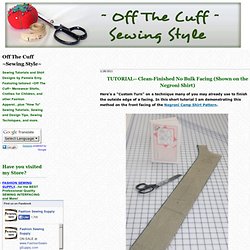

How to sew flat lining. One of my favourite sewing techniques is flat lining.

Flat lining is used extensively in historical (particularly 19th century) sewing and couture sewing, but it’s a technique that is not frequently taught or used in modern sewing books or patterns, which is a pity, because it’s awesome, and opens up many possibilities for design techniques and fabric use. I used it to make thin, flimsy fabrics strong enough to make corsets and jackets out of, and to make bodices that shape and hide squish without adding bulk and weight.
Though the terms are sometimes used interchangeably, flat lining is not quite the same thing as interlining. ! Interfacing Tips & Tricks. Fused Interfacing: Tailor's Tricks. Block Fusing is a method that many modern tailors and home-sewists use to apply interfacing to fashion fabric yardage before the pattern pieces are cut out.

Have you ever struggled keeping the interfacing layer from slipping off-grain as you attempt to fuse it to your fabric yardage? Next time, try this fast, easy, and accurate method that I learned from a Master Tailor, called "SPOT-FUSING"...And it can be done right on your cutting table! First, we need to prepare the surface of the table. The photo above shows my cutting table covered with 2 layers of HEAVY weight muslin (from Gorgeous Fabrics), and one layer of very thick wool (a heavy wool blanket will work as well..I just happen to have felted wool yardage that I use for this technique). It is VERY important that these layers be smooth and free of wrinkles, so thoroughly smooth them out before proceeding. Next, lay out your fashion fabric on top of your "padded" table, WRONG side UP...making SURE it is smooth. Understanding Lining Fabric + Resources.
This is a follow-up post to this post and again, if you don’t have Easy Guide to Sewing Linings by Connie Long, you need it and you should buy the e-book right now! Today, I wanted to share my online resources plus a few tips on what kinds of fabrics can work as a lining. Sometimes ideas from others make a big difference in how we view the usefulness of a fabric. So here goes. Bag Your Jacket Lining. Lining a jacket makes it last longer and become easier to slip on and off.

Best yet, using the bagging method is as quick or quicker than finishing an unlined jacket. Photo: Sloan Howard. by Sandra Millettfrom Threads #88, pp. 56-59 Sewing jackets is something I like to do, but lining them is another matter. By the time I get to that point in construction, I'm ready to put on my new jacket and sashay out the door. Sewing101: facings. For this week’s sewing 101, let’s talk about facing.

Facings are so easy to make and give your garment a professional finish, without a full lining. Of course you can face and line a garment, which makes it so nice and fancy on the inside. But facings on their own are more economical and great for keeping clothing lightweight. I use facings the most in necklines. There are lots of ways to finish garment necklines, but facings are my favorite, so nice and clean!
This tutorial is for a neckline facing, but you can apply the same principles to facing any part of your garment. Lay the scrap over the top of the bodice piece and trace the neckline. Now, use the same measurement (2″ for this example) and draw dots to mark two inches from the neckline. Lots of dots will make it easier! Connect all the dots to complete your pattern piece. Repeat for the front neckline and cut out your pieces. Then pin and sew. Press the seams open. And serge (or zig-zag) the bottom edge. Sew it on. Full facing tutorial - Salme Sewing Patterns.
Facing. Almost all of the tutorials I share use some form of facing.

However if you are new to sewing, or new to self drafting maybe you find yourself a little lost when it comes to facing. Honestly it was one of the things I always wanted to skip when I was first learning to sew, and interfacing? Forget it! Who needs it I would ask. Well let me tell you I have long abandoned that foolish thinking and have come to realize how easy and necessary both facing and interfacing can be. Let's start by the drafting of facing. From your bodice pattern you will simply follow the curve making a new one about two inches in from the edge. Now let's talk combination facing. Here are a few "twists" on facing. Interfacing. Interfacing used to reinforce a hem.

Interfacing is a textile used on the unseen or "wrong" side of fabrics to make an area of a garment more rigid. Interfacings can be used to:[1] stiffen or add body to fabric, such as the interfacing used in shirt collarsstrengthen a certain area of the fabric, for instance where buttonholes will be sewnkeep fabrics from stretching out of shape, particularly knit fabrics Fusible interfacing[edit] Most modern interfacings have heat-activated adhesive on one side. References[edit] Jump up ^ Moyes, Pat (1999).